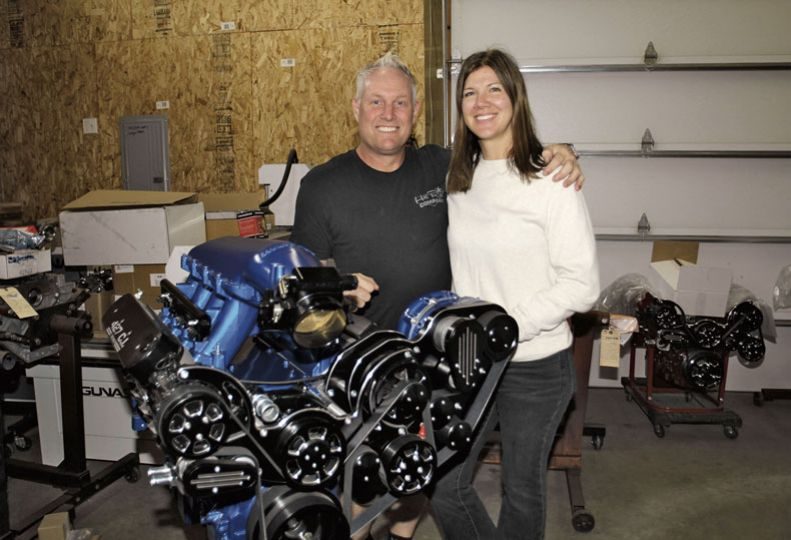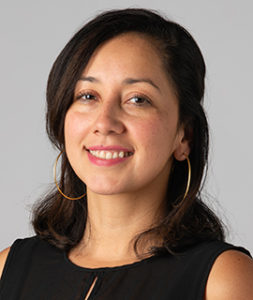
Home » Hot Rod Company to expand to $3M Valley facility
Hot Rod Company to expand to $3M Valley facility
Custom engine builder to have new showroom, full-service machine shop

October 12, 2023
The West Coast Performance Co., a Spokane Valley-based builder of custom high-performance engines, has been growing in revenue by 40% annually for the past five years, says JR and Katie Roby, the company’s co-founders and owners.
With its steady growth, West Coast Performance, which does business as The Hot Rod Company, has bought a $3 million, 17,000-square-foot manufacturing facility located at 12205 E. Empire, in Spokane Valley.
Hot Rod currently is assembling engines within a 9,600-square-foot building on the Roby’s 11-acre residential property in Spokane Valley. JR says he’s excited to move to a commercial area that will offer a showroom and a full-service machine shop.
“Now that we’re going to have a commercial location, we want to open that up to people and offer a top-notch service so that they can get the work they need done,” says JR of the new headquarters.
Katie says the new location also has two additional buildings totaling about 4,500 square feet, one of which will be used for executive offices.
“We’ve got a really great building, and I’m excited to see what our team is going to do in the new space,” she says.
Cate Moye, a broker with Spokane Valley-based Windemere Valley/Liberty Lake, was the purchasing agent in the transaction, and Joel Crosby, of Coldwell Banker Tomlinson Spokane, was the selling agent of the former T-2 Services Inc. facility, which provided welding services for nearly 30 years.
The Robys say the company will move into the new space next year after a renovation and deep clean. The couple hope to have a grand opening in the spring, which is typically the start of the car show season that lasts through the summer months. For instance, Hot Rod’s new headquarters are roughly two blocks from Stormin Norman’s Shipfaced Saloon, a popular destination for car show enthusiasts, he says. Participants in car shows starting in Coeur d’Alene often will stop at the restaurant for a meal before going on to the next location, he adds.
“I want to be able to have several car shows there and support their business, as well as them supporting us,” he says.
The Hot Rod Company was established in 2006 by the Robys as the couple was budgeting for their wedding. Not wanting to go into debt, JR listed an engine from one of his race cars on Craigslist for $5,000, and it sold within a day, they say.
“And the phone kept ringing and ringing,” says JR. “I told my wife, if the phone keeps ringing, I’m going to tell them it’s for sale and build another one. It wasn’t even an hour later, and another call came in and I said, yeah, it’s for sale.”
For the next several days, people kept calling, wanting to buy the engine from the original post, he says.
Today, the company has 18 employees and three independent contractors that include engine assemblers, a sales manager, computer numerical control machine operators, a cylinder head machinist, a shipping coordinator, and a shipping manager, says Katie.
The company plans to add 10 workers when it moves into the new facility, the Robys say.
Hot Rod assembles between 200 and 250 engines a month, with the cost of each engine ranging from $5,000 to $35,000, says JR. The company has shipped its custom-built, roughly 600-pound engines around the world, including to Australia, Saudi Arabia, Germany, Denmark, Argentina, and Canada. Some of Hot Rod’s customers include NFL teams and players and Hollywood movie studios and actors, including Mark Wahlberg, say the Robys.
An engine takes about two days to build, says JR. Each engine is built by only one person and when it’s finished, that person will sign their name on the engine block, he says. The company makes between $500 and $700 from each engine, a price point that he says most likely has helped the business grow. Most other hot rod companies charge $3,000 to $4,000 more per engine, and they are built in an assembly line, he says.
“We have less than 1% warranty issues,” says JR, a figure he attributes in part to the company’s strategy of one person being responsible for one engine at a time.
Of the engines that have been returned, he says its usually for minor issues or customer related failures, in which customers typically on a budget don’t want to spend the additional $500 for the company to put the engine on a stand, test it, and run it for four hours.
“When you first start an engine, you have to rev it at 2,500 rpm and hold it there. Some customers say it sounds good and don’t want to listen for four hours, but it only takes a couple of minutes of idling for it to fail,” he says.
Performance vehicles and drag racing are JR’s passion-turned-profession. Growing up in Salem, Oregon, his dad would drop him off at school “sideways and burning tires,” says JR.
After school, his chores included breaking down and building engines and transmissions with his dad. At 16, he began drag racing legally and entering competitions. He became a personal trainer for 24 Hour Fitness, which sponsored him as a driver and gave him a drag racing car and $30,000 a year to compete, he says.
“I basically drag raced all over the country,” he says. “That was the lifestyle I grew up on.”
In 2002, JR moved to Spokane to help open a new 24-Hour Fitness gym and continued to work as a personal trainer while he and Katie built their company, he says.
JR says performance vehicles were popular in the 1960s and 1970s, but because of gas prices and other factors, companies started moving away from those types of vehicles. In the last five years or so, however, performance cars made in the U.S. have started to return, he says.
“The Ford Mustang, the Dodge Hellcat, the Z1 Camaro, those are American cars,” says JR. “They are contending with the European cars that are 1,500 horsepower just because (car companies) have got back into what they were originally doing, and that’s performance cars.”
JR says that about 10 years ago, Spokane had more machine shops for building engine motors than most other locations. Some of those shops, however, have closed.
“A lot of businesses that had a storefront where you could walk in and get work done are out of business now,” says Katie. “There is still a need in the community and we’re ready to step in and fill that role.”
Latest News Up Close Manufacturing
Related Articles
Related Products


![Brad head shot[1] web](https://www.spokanejournal.com/ext/resources/2025/03/10/thumb/Brad-Head-Shot[1]_web.jpg?1741642753)

